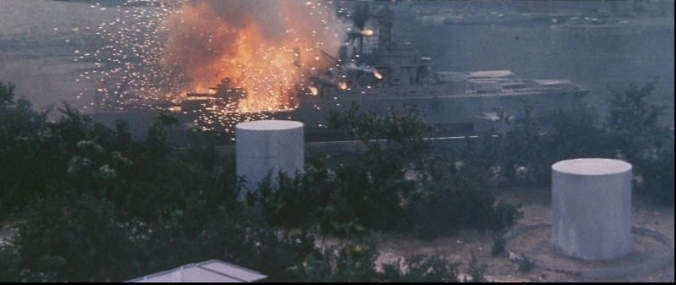 Hawaii Middowei daikaikusen is basically a standard war movie of the post-war era, which makes it symptomatic of a change in Japanese society. The comparison with The War at Sea, which was made in 1942 and covers much the same territory, is striking.
Hawaii Middowei daikaikusen is basically a standard war movie of the post-war era, which makes it symptomatic of a change in Japanese society. The comparison with The War at Sea, which was made in 1942 and covers much the same territory, is striking.
Obviously, the 1960 film in color and ‘scope feels more spectacular to contemporary eyes, and the model work seems on a par with any American film of the era. But what makes it striking is that the film has a hero, Lt. Koji Kitami, a great change from the Japanese approach during the war itself. Everything in The War at Sea stressed the team, the unit, the group all faithful to the Emperor and all but indistinguishable in character. Here we follow one young man, Koji, who is a pilot in the attack on Pearl Harbor. He returns home a great hero thinking his war is over, only to be called back to participate in great Battle of Midway, which is the real subject of the film.
This battle, seen from the Japanese side, is one of great confusion, as it was for the Americans as well. But we also focus on individual bravery, something essential to American and British war movies but new in Japanese war movies. Like all good war heroes in movies, Koji is shot down, but he is rescued and lives to fight again. And Koji begins to question the wisdom of the war itself, which would never have occurred in earlier war films.
We also see pretty much the entire Toho gang, including Toshiro Mifune, who goes down with his ship.
Presumably, the Midway battle sections are relatively accurate historically, particularly about the lack of current recon that left the Japanese unable to respond at the most critical moment while changing plane armament from bombs for Midway Island to torpedoes for ships. With the later American Midway, it probably provides as complete a view of the war’s most critical sea battle as fictional film can provide, so it offers more interest beyond our young hero’s travails than is typical in most war movies.
Like all naval war movies, this one is heavily dependent on the models, by Godzilla‘s Eiji Tsuburaya. But also like all model naval war movies, it suffers from the difficulty of personalizing fighting that takes place with the opponents miles apart.
A shortened version was released in America under the exploitation title I Bombed Pearl Harbor, which was badly dubbed and had half an hour missing. A subtitled version also existed in the US as Storm Over the Pacific, but it is possible to find the Japanese version with subtitles, if you are interested.
As a war movie, it is typical (though at this date still fairly unusual for Japan). As a view of the Japanese perception of a major battle, it is more than a little interesting, but not nearly as well made as, for example, Okamoto’s Battle of Okinawa.
Pingback: Last War / Sekai daisenso (1962) | Japanonfilm
Pingback: Nakano Spy School / School of Spies / Rikugun Nakano gakko (1966) | Japanonfilm
Pingback: Admiral Yamamoto (1968) | Japanonfilm
Pingback: Battle of the Sea of Japan / Nihonkai daikatsen (1969) | Japanonfilm
Pingback: Militarists / Gunbatsu (1970) | Japanonfilm